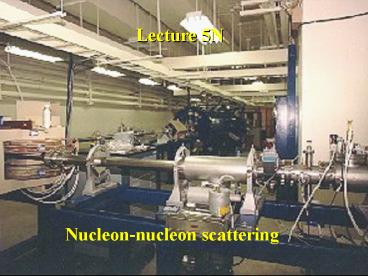Lecture 5N
1 / 34
Title: Lecture 5N
1
Lecture 5N
Nucleon-nucleon scattering
2
What we know about the nucleon-nucleon Force
from the deuteron
The nucleon-nucleon force depends on S. Does it
also depend on l? Cannot determine this from the
deuteron
3
Nucleon-nucleon scattering
From the deuteron we learned about N-N potential
for l0 and S1 (??)
- If we do N-N scattering we can
- have ?? (S1) or ?? (S0)
- vary l (by varying energy of incident beam)
- have n-n, n-p, and p-p interactions
4
Nucleon-nucleon scattering in principle
Classically when nucleons approach within the
range of the N-N force scattering occurs.
Quantum Mechanically the incoming wave suffers
a phase change in the region of the N-N potential
This leads to interference effects, and a
probability distribution for the scattered
particles that can be analysed in terms of the
potential-well depth and shape.
5
Nucleon-nucleon scattering
The analogy with optical scattering by an object
is close.
6
Nucleon-nucleon scattering
7
Neutron-proton scattering
WF for Free particle
WF after interacting with attractive potential
WF after interacting with repulsive potential
8
Neutron-proton scattering
WF for Free particle
WF after interacting with attractive potential
WF after interacting with repulsive potential
9
What do we need for scattering experiments?
A beam of projectiles
Usually protons since cannot accelerate neutrons
of known energy
An accelerator
10
Accelerating the protons The Van de Graaff
accelerator
11
Accelerating the protons The cyclotron
12
What do we need for scattering experiments?
A beam of projectiles
Usually protons since cannot accelerate neutrons
of known energy
An accelerator
A target of protons (H gas) for (p,p)
scattering. A target of deuterium gas for (p,n)
scattering.
A target
A detector to measure the number of scattered
particles at different angles
Solid state detectors (like Nuclear Lab. Magnetic
spectrometer
13
Relating the predictions to the measurements
Reaction Cross section
n nuclei per unit volume
So the number scattered in thickness t is
Unit for cross section is barn. (b) 1 b 10 28
m2
14
Differential cross section
15
Neutron-proton scattering
16
Neutron-proton scattering
In Phase-shift analysis it is usual to expand the
plane incoming wave in terms of a sum of
spherical harmonic functions.
17
Energy limits for l 0 scattering
Classical Calculation b 2 fm Ep(lab.) 10
MeV Ep(CM) 5 MeV AM 0.7 x 10-15 ev-s
Quantum AM For ? 1 AM 1 x 10-15 ev-s
18
Neutron-proton scattering
So if we use a proton beam of energy lt10 MeV we
need only consider l0 terms.
This also means that the scattering will be
essentially isotropic.
19
Neutron-proton scattering
Too complicated
a ?
For Ep lt few MeV ? gt nucleon size
a 5?
Thus we expect scattering cross section to get
more complex as Ep increases (? decreases), i.e.
l?1,2..
a 10?
20
Neutron-proton scattering
So what can we learn from l 0 n-p scattering?
S1 and S3 dependence of N-N potential
Nature of the repulsive core
Effect of l-s interaction
21
Neutron-proton scattering
Calculate the cross section for low-energy n-p
scattering
To find the effect of this phase change, well
away from the interaction, we add the incoming
plane wave and the scattered one
The number of particles, of vel v carried by this
wave per sec. in all directions is 4?r2(A2)
22
Neutron-proton scattering
To find ?, smoothly join the wavefunctions of
incoming and outgoing waves at the boundary of
the potential
Using the values from the deuteron V0 73 MeV b
1.34 fm c 0.4 fm gives values for ? as a
function of E.
This gives a value for ?np of 5 mb
23
Neutron-proton scattering
20!?
What went wrong?
We used N-N parameters for S1, from our Deuteron
discussion Thus only calculated the situation ??
(S1). In scattering we can also have ??
(S0). Coupling to ?? (S1) is 3 times as likely
as to ?? (S0).
The S3 and S1 parts of the N-N potential are very
different.
Thus the measured cross section is ? ¾ ?3 ¼
?1. We calculated ?3 5 b.
So 20 b ¾ (5 b) ¼ ?1? ¼ ?1 16 b ? ?1
64 b.
24
Neutron-proton scattering
a ?
For Ep lt few MeV ? gt nucleon size
a 5?
Thus we expect scattering cross section to get
more complex as Ep increases (? decreases), i.e.
l?1,2..
a 10?
25
Expected n-p scattering cross section
26
Classically why AD of high-energy n-p Scattering
is forward peaked
Classically the angle of deflection depends on
the impulse ?p. If P is large (fast) , then ?p
is small.
27
(No Transcript)
28
Classically why AD of high-energy n-p Scattering
is forward peaked
Classically the angle of deflection depends on
the impulse. If P is large (fast) , then ?p is
small.
?p/p F?t/p F(r/v)/mv r width of
potential V0/mv2 (F -dV/dr)
V0/K If K gt V0 angle of scattering is small
29
High-energy n-p scattering
What we might expect for high-energy scattering
30
Observed high-energy n-p scattering
31
High-energy n-p scattering
The interpretation with N-P exchange
32
High-energy n-p scattering
The interpretation with N-P exchange
In about 50 of interaction the proton becomes a
neutron and the neutron becomes a proton! Why is
this and how can we explain this exchange effect?
33
Nucleon-nucleon potential
central potential derived from study of the
deuteron (l 0, S 1)
effect of spin coupling between the 2 nucleons
tensor component
interaction of nucleon spin (s) and orbital AM l.
34
Neutron-proton scattering
- N-N potential depends on
- Coupling of spins
- Coupling between l and s
- s and r (tensor component)
For Lgt0, and study of repulsive core need higher
energy scattering.































